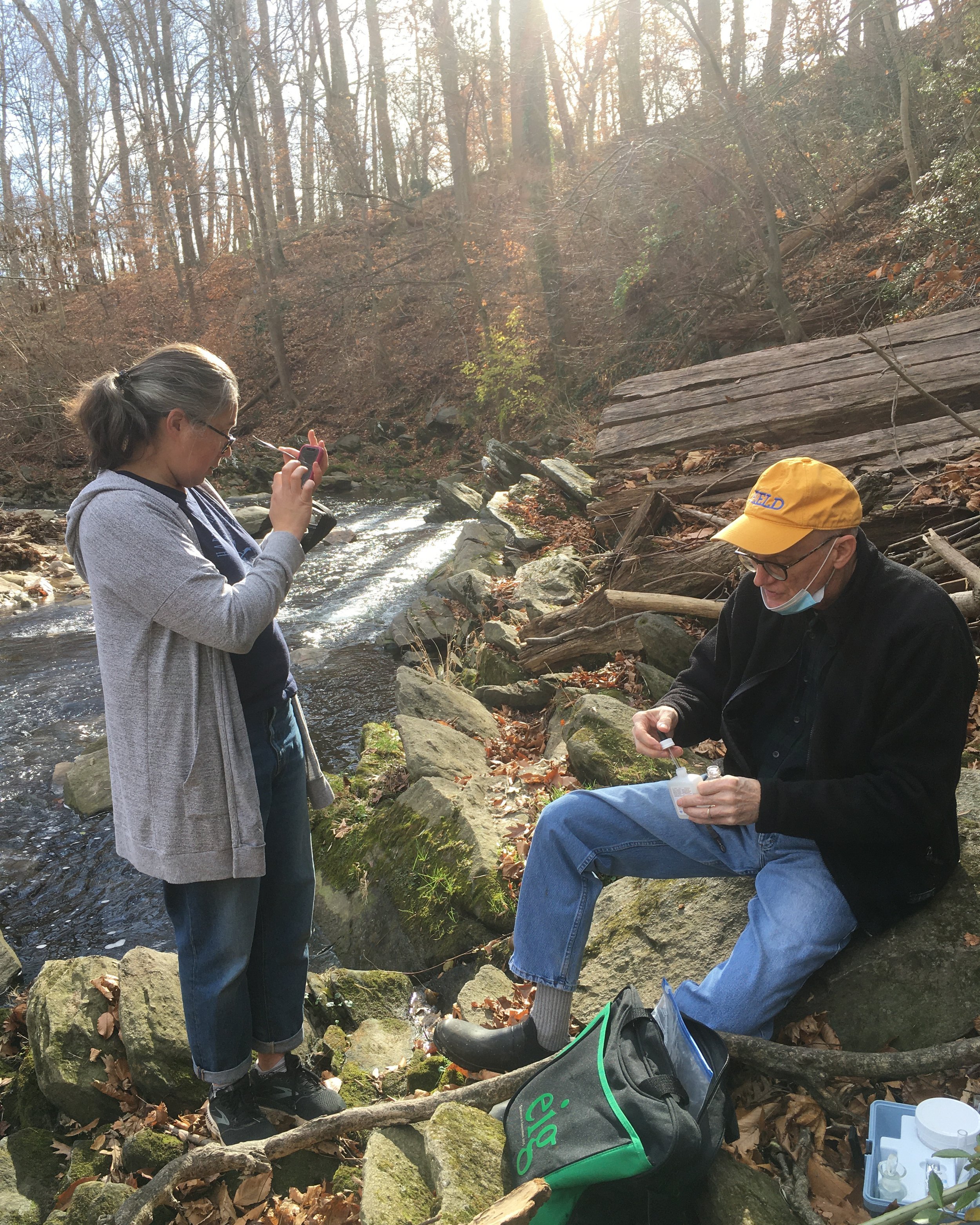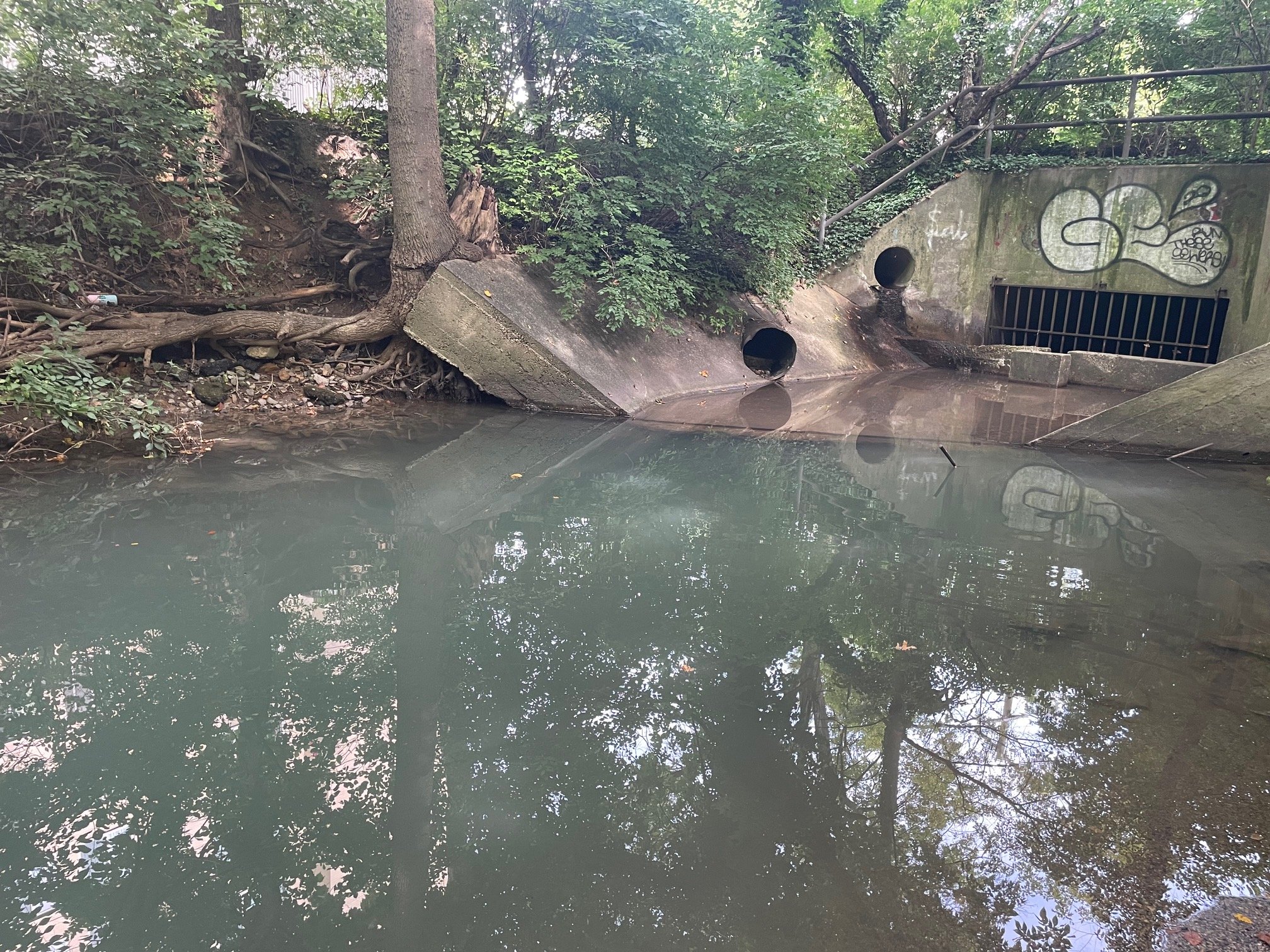Jane Padelford Gomes was recognized for her tremendous contribution to the watershed, the Green Acres Habitat Restoration. This project, started by Jane in 2016, has transformed the muddy, invasive overgrown “paper road” between Wakefield and Yorktown Roads in Bethesda into a haven of native plants alive with song birds, butterflies, bees and other native insects.
We Win! Most Volunteer Hours by a Weed Warrior Supervisor.
The Montgomery Parks has published their 2023 numbers for Weed Warriors and there are some pretty impression efforts in the County Park system for removing non-native invasive plants. 2023 was a record-breaking year for the program; there were 12,490 total Weed Warrior hours for the year.
Sarah Morse on the left on the Capital Crescent Trail instructing a work group on how to remove bush honeysuckle.
Little Falls Watershed Alliance Executive Director Sarah Morse leads the pack for the most hours recorded by a Weed Warrior supervisor. Weed Warrior supervisors have special training and are allowed to lead community workdays that are open to the public. Sarah led 20 workdays on Park land in 2023 supervising 838.5 man hours. Sarah also leads workdays on State Highway land, in DC Parks, and in the Montgomery County Public Schools Forest Conservation Land for a total of 25 events in 2023.
Weed Warrior Supervisor Celia Martin was not far behind leading 24 events in the Little Falls Stream Valley Park for 685 supervisor hours.
We also have 23 Certified Weed Warriors working in the Little Falls watershed. Certified Weed Warriors have attended the Montgomery Parks Weed Warrior training and are allowed to work unsupervised in the Parks. More about how you can become a certified Weed Warrior is HERE.
What did the Little Falls Weed Warriors do?
According to the Parks data, we freed 1,142 trees from strangling vines and smothering bushes.
And our most popular plant to conquer was porcelain-berry vines, followed by English ivy, and then bush honeysuckle. We also removed oriental bittersweet, Japanese honeysuckle, creeping euonymus, garlic mustard (in the spring), wine berry, winged euonymus, leatherleaf mahonia, Japanese knotweed, mile-a-minute, Italian arum, bamboo, privet, multi-flora rose, chocolate vine, pachysandra, and more.
where did we work?
Sarah works primarily along the Capital Crescent Trail and in the Little Falls Stream Valley Park above River Road. Celia hosts her work days below Massachusetts Avenue in the lower part of the Little Falls Stream Valley Park, in Westmoreland Hills Local Park and along the Capital Crescent Trail. But we have other certified weed warriors working at sites all over the watershed.
According to Park data, work sites in the Little Falls Watershed by the number of workdays are:
Boundary Park NCA: 2
Capital Crescent Trail: 26
Little Falls SVU 1 (South of River Rd): 44
Little Falls SVU 2 (North of River Rd): 28
Norwood LP: 14
Westmoreland Hills LP: 14
Join the Mission - Get Certified, Participate in a community event
It’s against Montgomery Parks rules and regulations to remove plant material from a park unless authorized. That’s where the Weed Warrior Program comes in. By training and certifying citizens to remove non-native invasives from parkland, Montgomery County has a robust program that allows residents to help save our forests.
Sign-up for an Event: You can join one of our community workdays by visiting our events page and registering. We provide all necessary tools and gloves as well as instructions. Our workdays are open to everyone, but students under 14 must be accompanied by a supervising adult. No experience or previous training necessary.
Book a Private Event: We host dozens of workdays for office groups, civic groups, scouts, or just any group looking to make a difference. We provide tools, gloves, and a supervisors, you provide manpower. These days are arranged at mutually convenient times. Contact us at info@LFWA.org for more information.
Become a Certified Weed Warrior: Montgomery County certification program trains individuals to identify and remove non-native invasives. After receiving their “green card”, the weed warriors can work anywhere in the Park system without supervision. There is online training as well as in person training days. More information HERE.
Winter Monitoring Nets Two Types of Crane Flies!
No Snow Yet, but Salt Levels are High in the Watershed
LFWA citizen scientists are busy at work again, this time testing for salt pollution in our creeks. While the 3 inches of rain last weekend washed away much of the salt pollution, the baseline tests taken in mid-December showed high levels of salt - almost to the chronic level. This is alarming as the freshwater organisms who live in the creek, cannot survive when the salinity of the water gets too high. The saline levels are caused by road salt which makes its way into the creek through run-off when the salt melts.
Baseline results from December 16.
These high levels at the beginning of winter are a reminder of long lasting effects of road salt.
Just a sprinkle will do.
High baseline levels are also a reminder to keep salting to minimum on your sidewalks and driveways. We want people to be safe, but we also want healthy creeks. So read the instructions on the salt containers carefully and remember more is not better. A 12 ounce coffee cup holds enough salt to treat a 20 foot driveway! And if there is salt still on the pavement after the storm - you can sweep it up and save it for another storm.
call 311 to report salt spills
Montgomery County is committed to responsible salt treatment of public roads and sidewalks. This means removing piles of excess salt. Please, if you see piles of salt on your street or other public areas, call 311 to report. They will come out and clean it up.
More information about the LFWA Salt Watch program and Salt Wise winters HERE.
Montgomery County maintenance crew cleaning up excess salt in the Westbrook neighborhood after receiving a 311 call from a resident.
New Year's Bird Count, Norwood Park
Snow Plow Painting Raises Awareness of Road Salt Toxicity
Report Concludes Area Streams have a Serious Fecal Bacteria Problem
For the third consecutive summer, the fecal bacteria levels in the Little Falls watershed have exceeded the Maryland State Standards for recreational water use - even for infrequent human contact. According to the 15 week study of eight sites along two creeks in the watershed, both creeks at all locations fail to meet the criteria for safe water play.
Stream Scores Poor in Fall Monitoring
Thanks to everyone for an efficient and productive Fall Monitoring. With a plethora of volunteers - there were 9 of us - we recorded 106 macro's. Watching small minnow mayflies take flight might have been the highlight of the day or possibly finding one Narrow Winged Damsel Fly (thanks to Averill!).
Illegal Discharge in the Creek? If You See Something, Say Something!
August 8, 2023: Dead fish in the Little Falls Branch by Willard Avenue Park in Chevy Chase, MD.
Kudos to our trash volunteers who noticed dead fish and a weird smell in the Little Falls Branch at Willard Avenue Park in Chevy Chase during our August clean-up. They reported the problem to our trash host who passed it along to Steve Martin at the Montgomery County Department of Environment. Steve and his crew were able to track down at least some of the problem and a local pool was found to have discharged muriatic acid into the creek. The pool management company was issued a citation.
Thank you to our trash host Emily Simone for following up on this and to the MoCo DEP for their prompt and successful investigation.
how to report problems in the creek
This is not the first time that LFWA has reported a problem to the County with success. Illegal discharges are common in the creek and quite often the DEP is able to track the source and have the problem fixed. But they can’t do it without the help of residents. The key to a successful outcome is prompt reporting with lots of details, pictures and maps. There are two ways to report:
Call 311 - this non-emergency number will take your report and relay it to the right department. 311 is only available Monday to Friday from 7:00 am to 7:00 pm. Call 911 for emergency service when 311 is closed.
Email Environmental Compliance Supervisor directly at Steve.Martin@montgomerycountymd.gov Be sure to include photos and a map along with the date of observation. Please copy us at info@LFWA.org if you do email. We will also follow up.
Examples of problems you might report include paint, construction silt, dead fish, funny smells, weird colored water, lots of foam from soap suds, and of course, plain old dumping,
Murky water on the Little Falls Branch coming from an outlet near Willard Avenue in Chevy Chase. Dead fish and an abnormally low pH were found below this outlet. Photo taken on August 8, 2023.






